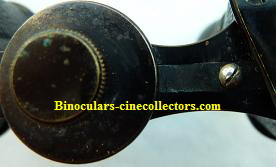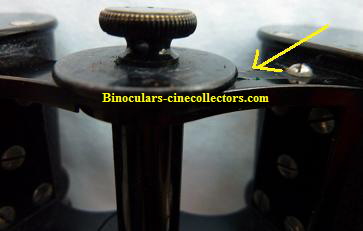|
|
Inter-Ocular Distance Gauge - Carl Zeiss Jena
This Inter-Ocular Distance Gauge was produced in ca. 1900 by Carl Zeiss Jena.
The purpose of the production of this instrument was to measure the distance between the eye pupils.
The device is made from cardboard as a flat box of measurements: 13, 5 cm x 9 cm x 1, 5 cm.
The interior of the box
It is difficult to specify whether the instrument was produced in large quantities.
The lid of the instrument
As we can read on the lid, the device was added for free to some Carl Zeiss binoculars bought in England:
- Field glass;
- Stereo-Hand-Telescope;
- Stereo-Stand-Telescope;
- Stereo-Telemeter.
After measuring the distance between the eyes pupils, using the device, binoculars’ buyer could adjust a distance between eyepieces of his binocular for optimal performance.
Eye width top plate of the binocular
At that period of the production Carl Zeiss binoculars, they had a special feature. On the opposite side of the eye width top plate was fitted a screw with a hole through to preserve the distance between eyepieces.
CZJ Feldstecher 4 Fach, Production No 3356; in our collection
The binoculars had a special Tommy bar in accessories.
CZJ Feldstecher 4 Fach, Production No 3356, with the Tommy bar; in our collection
The Tommy bar is fitted into a tiny sleeve in the binocular case.
The case for CZJ Feldstecher 4 Fach with the Tommy bar in the sleeve; in our collection
Once the distance between eyepieces was accustomed, using the Tommy bar and lightly screwing, the measure has been maintained.
CZJ Feldstecher 4 Fach with the Tommy bar in the hole;
The mechanism in the hinge bar has been learnt where is located the adjusted point of the binoculars’ owner.
Using the binocular the owner did not have to remember his distance between eye pupils. Bending binocular the adjusted point gives a characteristic click and a spring at the bottom hinge is going up.
 
CZJ Feldstecher 4 Fach with the spring up;
In this way the binocular would be used by other watchers.
The later CZJ binoculars models, ca 1907 were fitted with much easier this mechanism. It was not Tommy bar used for the adjustment. The screw was tightened by hand.
The Inter-Ocular Distance Gauge was seen with the description in German language as well.
After the war was seen Russian Army 12 x 60 box set for rangefinder made in 1950s, which included a Russian copy of this instrument.
The only difference of the copy was the material from which the box was made. It was built up from metal.
Presumably, this tool was produced in all countries of the Warsaw Pact, at the time.
In this way we do not know if the instrument was produced only to enhance the attractiveness of buying some binoculars or it was a large volume production.
On the reverse side we see the advertisement of the newly produced Field glass.
The back side of the instrument
In addition, to the binocular picture appearing on this side is also information that a buyer of the optical items can apply for a free edition of the Carl Zeiss catalogue.
It is furthermore given additional information about the other items produced by Carl Zeiss and described in the catalogue:- Binoculars, monocular, telescopes, rangefinders, stereo-telemeters;
- Microscopes, and microscope accessories;
- Cine items;
- Photographic optical items;
- Optical measuring instruments;
- Astronomical object-glasses and instruments.
At that time the Carl Zeiss binoculars were expensive. They were more expensive than other manufacturers.
Giving the Inter-Ocular Distance Gauge as a gift Carl Zeiss provided itself with advertising for the other optical products.
On the inside of the lid of the Inter-Ocular Distance Gauge is attached full instruction on how to carry out a test.
The instruction for performing the test
The interior of the instrument is built in a very simple way. It contains two small mirrors on one side and two scales in opposite. The scales are printed as seen in the mirror.
The interior for the taking the test
The scale on right is of the same measurement as it is on eye width top plate of the binoculars.
The test is very simple. The left pupil must be seeing in the mirror in this way, as the zero mark lies below the centre of the pupil.
The image in the left mirror
The number read in the right mirror, corresponds to the inter-ocular distance and the interval between the pupils of the eyes when looking into the distance.
The sample image in the left mirror
The producer of the appliance additionally informed: “Most reliable Inter-Ocular Distance Gauge for Ophthalmic Surgeons, Oculists and Opticians, focusable for short and long sight, in case Marks 50”
We will never know what a pair of binocular was sold together with this instrument.
However the device is remarkable and mechanism of holding the test is effortless.
|
|